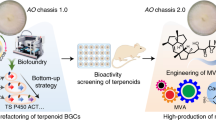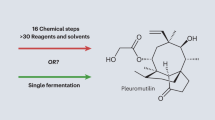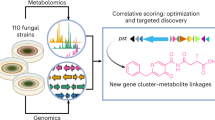Abstract
The genomes of filamentous fungi contain up to 90 biosynthetic gene clusters (BGCs) encoding diverse secondary metabolites—an enormous reservoir of untapped chemical potential. However, the recalcitrant genetics, cryptic expression, and unculturability of these fungi prevent scientists from systematically exploiting these gene clusters and harvesting their products. As heterologous expression of fungal BGCs is largely limited to the expression of single or partial clusters, we established a scalable process for the expression of large numbers of full-length gene clusters, called FAC-MS. Using fungal artificial chromosomes (FACs) and metabolomic scoring (MS), we screened 56 secondary metabolite BGCs from diverse fungal species for expression in Aspergillus nidulans. We discovered 15 new metabolites and assigned them with confidence to their BGCs. Using the FAC-MS platform, we extensively characterized a new macrolactone, valactamide A, and its hybrid nonribosomal peptide synthetase–polyketide synthase (NRPS–PKS). The ability to regularize access to fungal secondary metabolites at an unprecedented scale stands to revitalize drug discovery platforms with renewable sources of natural products.
This is a preview of subscription content, access via your institution
Access options
Access Nature and 54 other Nature Portfolio journals
Get Nature+, our best-value online-access subscription
$29.99 / 30 days
cancel any time
Subscribe to this journal
Receive 12 print issues and online access
$259.00 per year
only $21.58 per issue
Buy this article
- Purchase on Springer Link
- Instant access to full article PDF
Prices may be subject to local taxes which are calculated during checkout




Similar content being viewed by others
Accession codes
References
Blackwell, M. The fungi: 1, 2, 3 . . . 5.1 million species? Am. J. Bot. 98, 426–438 (2011).
Khaldi, N. et al. SMURF: genomic mapping of fungal secondary metabolite clusters. Fungal Genet. Biol. 47, 736–741 (2010).
Inglis, D.O. et al. Comprehensive annotation of secondary metabolite biosynthetic genes and gene clusters of Aspergillus nidulans, A. fumigatus, A. niger and A. oryzae. BMC Microbiol. 13, 91 (2013).
Han, X., Chakrabortti, A., Zhu, J., Liang, Z.X. & Li, J. Sequencing and functional annotation of the whole genome of the filamentous fungus Aspergillus westerdijkiae. BMC Genomics 17, 633 (2016).
Andersen, M.R. et al. Accurate prediction of secondary metabolite gene clusters in filamentous fungi. Proc. Natl. Acad. Sci. USA 110, E99–E107 (2013).
Brown, D.W. & Proctor, R.H. Insights into natural products biosynthesis from analysis of 490 polyketide synthases from Fusarium. Fungal Genet. Biol. 89, 37–51 (2016).
Medema, M.H. et al. Minimum information about a biosynthetic gene cluster. Nat. Chem. Biol. 11, 625–631 (2015).
Anyaogu, D.C. & Mortensen, U.H. Heterologous production of fungal secondary metabolites in Aspergilli. Front. Microbiol. 6, 77 (2015).
Bailey, A.M. et al. Characterisation of 3-methylorcinaldehyde synthase (MOS) in Acremonium strictum: first observation of a reductive release mechanism during polyketide biosynthesis. Chem. Commun. (Camb.) 2007, 4053–4055 (2007).
Holm, D.K. et al. Molecular and chemical characterization of the biosynthesis of the 6-MSA-derived meroterpenoid yanuthone D in Aspergillus niger. Chem. Biol. 21, 519–529 (2014).
Richter, L. et al. Engineering of Aspergillus niger for the production of secondary metabolites. Fungal Biol. Biotechnol. http://dx.doi.org/10.1186/s40694-014-0004-9 (2014).
Nielsen, M.T. et al. Heterologous reconstitution of the intact geodin gene cluster in Aspergillus nidulans through a simple and versatile PCR based approach. PLoS One 8, e72871 (2013).
Heneghan, M.N. et al. First heterologous reconstruction of a complete functional fungal biosynthetic multigene cluster. ChemBioChem 11, 1508–1512 (2010).
Chiang, Y.M. et al. An efficient system for heterologous expression of secondary metabolite genes in Aspergillus nidulans. J. Am. Chem. Soc. 135, 7720–7731 (2013).
Smith, D.J., Burnham, M.K., Edwards, J., Earl, A.J. & Turner, G. Cloning and heterologous expression of the penicillin biosynthetic gene cluster from Penicillium chrysogenum. Bio/Technology 8, 39–41 (1990).
Gressler, M., Hortschansky, P., Geib, E. & Brock, M. A new high-performance heterologous fungal expression system based on regulatory elements from the Aspergillus terreus terrein gene cluster. Front. Microbiol. 6, 184 (2015).
Lazarus, C.M., Williams, K. & Bailey, A.M. Reconstructing fungal natural product biosynthetic pathways. Nat. Prod. Rep. 31, 1339–1347 (2014).
Weber, T. et al. antiSMASH 3.0—a comprehensive resource for the genome mining of biosynthetic gene clusters. Nucleic Acids Res. 43, W237–W243 (2015).
Bok, J.W. et al. Fungal artificial chromosomes for mining of the fungal secondary metabolome. BMC Genomics 16, 343 (2015).
Samson, R.A. et al. Phylogeny, identification and nomenclature of the genus Aspergillus. Stud. Mycol. 78, 141–173 (2014).
Smith, C.A., Want, E.J., O'Maille, G., Abagyan, R. & Siuzdak, G. XCMS: processing mass spectrometry data for metabolite profiling using nonlinear peak alignment, matching, and identification. Anal. Chem. 78, 779–787 (2006).
Ridder, L. et al. Automatic chemical structure annotation of an LC-MS(n) based metabolic profile from green tea. Anal. Chem. 85, 6033–6040 (2013).
Sun, H.H., Barrow, C.J. & Cooper, R. Benzomalvin D, a new 1,4-benzodiazepine atropisomer. J. Nat. Prod. 58, 1575–1580 (1995).
Jang, J.P. et al. Benzomalvin E, an indoleamine 2,3-dioxygenase inhibitor isolated from Penicillium sp. FN070315. J. Antibiot. (Tokyo) 65, 215–217 (2012).
Sun, H.H., Barrow, C.J., Sedlock, D.M., Gillum, A.M. & Cooper, R. Benzomalvins, new substance P inhibitors from a Penicillium sp. J. Antibiot. (Tokyo) 47, 515–522 (1994).
Wei, H. et al. Cytotoxic sesterterpenes, 6-epi-ophiobolin G and 6-epi-ophiobolin N, from marine derived fungus Emericella variecolor GF10. Tetrahedron 60, 6015–6019 (2004).
Yoganathan, K. et al. Inhibition of the human chemokine receptor CCR5 by variecolin and variecolol and isolation of four new variecolin analogues, emericolins A-D, from Emericella aurantiobrunnea. J. Nat. Prod. 67, 1681–1684 (2004).
Liu, H.-B. et al. Ophiobolin sesterterpenoids and pyrrolidine alkaloids from the sponge-derived fungus Aspergillus ustus. Helv. Chim. Acta 94, 623–631 (2011).
Molander, G.A., Quirmbach, M.S., Silva, L.F. Jr., Spencer, K.C. & Balsells, J. Toward the total synthesis of variecolin. Org. Lett. 3, 2257–2260 (2001).
Stachelhaus, T., Mootz, H.D. & Marahiel, M.A. The specificity-conferring code of adenylation domains in nonribosomal peptide synthetases. Chem. Biol. 6, 493–505 (1999).
Chiang, Y.M. et al. Molecular genetic mining of the Aspergillus secondary metabolome: discovery of the emericellamide biosynthetic pathway. Chem. Biol. 15, 527–532 (2008).
Cacho, R.A. et al. Understanding programming of fungal iterative polyketide synthases: the biochemical basis for regioselectivity by the methyltransferase domain in the lovastatin megasynthase. J. Am. Chem. Soc. 137, 15688–15691 (2015).
Meehan, M.J. et al. FT-ICR-MS characterization of intermediates in the biosynthesis of the α-methylbutyrate side chain of lovastatin by the 277 kDa polyketide synthase LovF. Biochemistry 50, 287–299 (2011).
Zou, Y. et al. Methylation-dependent acyl transfer between polyketide synthase and nonribosomal peptide synthetase modules in fungal natural product biosynthesis. Org. Lett. 16, 6390–6393 (2014).
Gatto, G.J. Jr., McLoughlin, S.M., Kelleher, N.L. & Walsh, C.T. Elucidating the substrate specificity and condensation domain activity of FkbP, the FK520 pipecolate-incorporating enzyme. Biochemistry 44, 5993–6002 (2005).
Gao, X. et al. Cyclization of fungal nonribosomal peptides by a terminal condensation-like domain. Nat. Chem. Biol. 8, 823–830 (2012).
Henke, M.T. & Kelleher, N.L. Modern mass spectrometry for synthetic biology and structure-based discovery of natural products. Nat. Prod. Rep. 33, 942–950 (2016).
Bouslimani, A., Sanchez, L.M., Garg, N. & Dorrestein, P.C. Mass spectrometry of natural products: current, emerging and future technologies. Nat. Prod. Rep. 31, 718–729 (2014).
Albright, J.C. et al. Large-scale metabolomics reveals a complex response of Aspergillus nidulans to epigenetic perturbation. ACS Chem. Biol. 10, 1535–1541 (2015).
Kuhl, C., Tautenhahn, R., Böttcher, C., Larson, T.R. & Neumann, S. CAMERA: an integrated strategy for compound spectra extraction and annotation of liquid chromatography/mass spectrometry data sets. Anal. Chem. 84, 283–289 (2012).
Bok, J.W. & Keller, N.P. LaeA, a regulator of secondary metabolism in Aspergillus spp. Eukaryot. Cell 3, 527–535 (2004).
Wang, M. et al. Sharing and community curation of mass spectrometry data with Global Natural Products Social Molecular Networking. Nat. Biotechnol. 34, 828–837 (2016).
Kessner, D., Chambers, M., Burke, R., Agus, D. & Mallick, P. ProteoWizard: open source software for rapid proteomics tools development. Bioinformatics 24, 2534–2536 (2008).
Running, W. Computer software reviews. Chapman and Hall Dictionary of Natural Products on CD-ROM. J. Chem. Inf. Comput. Sci. 33, 934–935 (1993).
Laatsch, H. Antibase 2011 (Wiley VCH, 2011).
Copeland, N.G., Jenkins, N.A. & Court, D.L. Recombineering: a powerful new tool for mouse functional genomics. Nat. Rev. Genet. 2, 769–779 (2001).
Muyrers, J.P., Zhang, Y. & Stewart, A.F. Techniques: recombinogenic engineering—new options for cloning and manipulating DNA. Trends Biochem. Sci. 26, 325–331 (2001).
Ames, B.D. & Walsh, C.T. Anthranilate-activating modules from fungal nonribosomal peptide assembly lines. Biochemistry 49, 3351–3365 (2010).
Al-Said, N.H. Effective formal synthesis of benzomalvin A. Monatsh. Chem. 141, 1249–1251 (2010).
Acknowledgements
This work was supported in part by the US National Institutes of Health (National Institute of Allergy and Infectious Diseases SBIR award in the form of grant R44AI094885 to C.C.W., J.W.B., and N.L.K.; grant R01AT009143 to N.L.K.; grant R01-AI065728 to N.P.K.; grant 5T32GM105538-04 to G.P.M.). NMR instrumentation and assistance was provided by the Integrated Molecular Structure Education and Research Center (IMSERC) at Northwestern University.
Author information
Authors and Affiliations
Contributions
R.Y., C.C.W., M.L., and M.N.I. worked on the FAC library assembly, FAC end sequencing, FAC DNA preparation, and FAC engineering. C.C.W., J.M.P., C.C., and M.L. carried out fungal secondary metabolite gene cluster prediction, FAC bioinformatic analyses, and FAC next-generation sequencing assembly and annotation. J.W.B., T.V., and K.H.Y. performed the A. nidulans transformation with FACs and prepared samples for metabolite identification and structure determination. K.D.C. and P.G. carried out LC–mass spectrometry analyses. K.D.C. conducted analysis of LC–mass spectrometry data, including development of the analysis pipeline, invention of the FAC-Score, discovery of valactamide A, and bioinformatic analyses of the benzomalvin and valactamide gene clusters, under the supervision of P.M.T. and N.L.K. P.M.T. identified benzomalvin A. G.P.M. carried out total synthesis of benzomalvin A/D. M.H.V., G.P.M., and K.D.C. carried out purification and structural characterization of valactamide A. The paper was written by K.D.C. under the supervision of N.L.K. The Online Methods and supplementary material were prepared by K.D.C., N.P.K., C.C.W., J.W.B., R.Y., G.P.M., M.H.V., and M.T.R. All authors read and approved the final draft of the manuscript. C.C.W., N.P.K., and N.L.K. conceived of and supervised the project.
Corresponding authors
Ethics declarations
Competing interests
The authors declare no competing financial interests.
Supplementary information
Supplementary Text and Figures
Supplementary Results, Supplementary Tables 1–8 and Supplementary Figures 1–23 (PDF 19593 kb)
Rights and permissions
About this article
Cite this article
Clevenger, K., Bok, J., Ye, R. et al. A scalable platform to identify fungal secondary metabolites and their gene clusters. Nat Chem Biol 13, 895–901 (2017). https://doi.org/10.1038/nchembio.2408
Received:
Accepted:
Published:
Issue Date:
DOI: https://doi.org/10.1038/nchembio.2408
This article is cited by
-
Molecular regulation of fungal secondary metabolism
World Journal of Microbiology and Biotechnology (2023)
-
Combined assembly of long and short sequencing reads improve the efficiency of exploring the soil metagenome
BMC Genomics (2022)
-
Efficient exploration of terpenoid biosynthetic gene clusters in filamentous fungi
Nature Catalysis (2022)
-
Cas12a-assisted precise targeted cloning using in vivo Cre-lox recombination
Nature Communications (2021)
-
Natural products in drug discovery: advances and opportunities
Nature Reviews Drug Discovery (2021)



